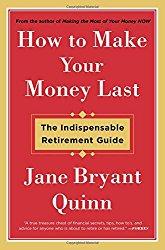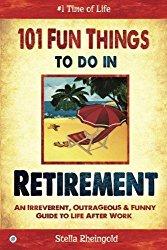Hopefully, you’ve heard the 4% rule, where you can withdraw about 4% of your retirement portfolio the first year of retirement and then increase that amount for inflation each year. You can then figure out how much you’ll need to save up by 1) figuring out how much you’ll each year for living expenses, 2) guessing that you’ll get about $15,000 per year from Social Security so subtracting $15,000 per year from living expenses, then 3) multiply the difference by 25 to find the total amount needed (multiplying by 25 is the same things as dividing by 4%). If you want to be really safe, multiply by 25 or 30 to reduce the chance you’ll burn through your portfolio early. Oh, and also add $400,000 to the total for a couple ($200,000 for a single) for medical expenses.
So, if you’re a couple and want $50,000 per year for living expenses. The calculation would look like this:
Income needed = $50,000 – $15,000 = $35,000
Retirement money needed = 25*$35,000 + $400,000 = $1,275,000

Hey – if you like The Small Investor, help keep it going. Buy a copy of SmallIvy Book of Investing: Book1: Investing to Grow Wealthy
I would actually recommend trying to have extra money saved up so that you could invest the extra fully in stocks, which have a larger return than bonds, while you invest the money you really need about 50-50 in bonds and stocks. (This mix of stocks and bonds is right at retirement – you would add more bonds as you got older to reduce the effects of a stock market decline, roughly keeping the bond percentage equal to your age minus 10%.) Because stocks average about 12% per year, you could withdraw about 8% per year from this extra money and have a good chance of getting 15-25 years of extra income that you could use for fun and giving. The extra 4% you would earn would allow the funds to keep up with inflation. For example, with an extra $1M, this would be:
Extra money = $1,000,000* 0.08 = $80,000 per year
Total Income = $35,000 (main account) + $80,000 (extra account) = $115,000

Because this is extra money, if you had a couple of years where stock market returns were low or even negative, it would just mean that your extra money would decline a little. You could also choose to not take 10% (or not take anything at all) if there is a decline and wait a year or two for the market to recover, which it usually does, then continue to take withdrawals at 10%. That is why you can take the risk of being fully in stocks. If it runs out in 10 years, you’re still covered by your main account.
Having the extra money also helps protect you should you see a big market decline early in your retirement. If the market drops 40% the first year you retire like it did in 2008, you could shift some of the money from your extra portfolio into your main portfolio to provide enough income for daily expenses. While it is mainly for extra income, saving up more is also an insurance policy against market declines. (Note that while the stock market fell by 40% in 2008, the bond market actually rose, so having a 50-50 mix of bonds and stocks would have meant your account would only be down by 15-20% and you might have been able to just wait a year for the stock market to recover without adding to your main portfolio.)


These funds will typically be in a 401k or an IRA. If you have a traditional IRA or 401k, where you will be taxed at ordinary income rates when you withdraw money, you’ll need to take taxes into consideration. You can figure that you’ll pay about 15% taxes on the withdrawals (20% if you want to be safe), so you should increase the amount you need by 15-20%. To figure out how much you need to save for retirement, just take your retirement money needed amount and multiply by 1.15 or 1.20:
Assuming 15% taxes and a conservative, 3% withdrawal rate:
Retirement money needed with taxes = $1,405,000 * 1.15 = $1,615,750
Retirement money needed with taxes = $1,405,000 * 1.20 = $1,686,000
If you are using a Roth IRA or 401k, because the taxes are taken out before you put the money into the account, the withdrawals are tax-free. This means you

I know it seems like a lot of money, and it is. We’re talking about $2.7M in a traditional IRA or 401k if you want to have enough for expenses plus extra money coming in each year, which is probably more money than many people expect to see in their lifetimes. The good news is, if you start early, it really isn’t all that difficult to amass such a sum. That is the beauty of compounding. Here’s how it works:
You can assume a return of about 8% after inflation if you invest fully in a diversified set of stock mutual funds. If you start investing at age 20, right when you start your first job, you’ll only need to put about $260 per month away to reach $2.7 M by age 70. If the stock market does even better, you might have $4M, or you might be able to retire at 62 or 65 instead of waiting until age 70. The beauty of investing in a 401K or IRA, as opposed to the old-fashioned pension plan where the employer decides when you can retire, is that you can flex things based on how the market is doing. If you have a good market from the time you’re 60 to 65, you can retire early. If things go south, you can stay on a few more years and let things rebuild.

Want all the details on using Investing to grow financially Independent? Try The SmallIvy Book of Investing.
The best plan is to sign up for the company 401k (if they offer one) or start an IRA as soon as you start working and start putting money away before you get used to the extra income. If you start out making $50,000 per year, put away 10% into the 401k plan, which would be about $420 per month. Hopefully, your company will match part of your contribution, so you might end up putting $600 or more away each month. If you do so, you’ll have about $4.4M at age 70. At age 65 you’ll have more than $3M, so you could retire a bit early.
If you wait until you’re 30 before you start putting money away, you’ll still have about $2M at age 70. Wait until you’re 40, and you’ll only have $880,000 at age 70, so you’d need to work until you’re 75 or 80 before you could retire securely. This is assuming that you don’t get laid off or have health problems that force you to retire. Starting early is the best way.
Have a burning investing question you’d like answered? Please send to [email protected] or leave in a comment.
Follow on Twitter to get news about new articles. @SmallIvy_SI
Disclaimer: This blog is not meant to give financial planning or tax advice. It gives general information on investment strategy, picking stocks, and generally managing money to build wealth. It is not a solicitation to buy or sell stocks or any security. Financial planning advice should be sought from a certified financial planner, which the author is not. Tax advice should be sought from a CPA. All investments involve risk and the reader as urged to consider risks carefully and seek the advice of experts if needed before investing.
